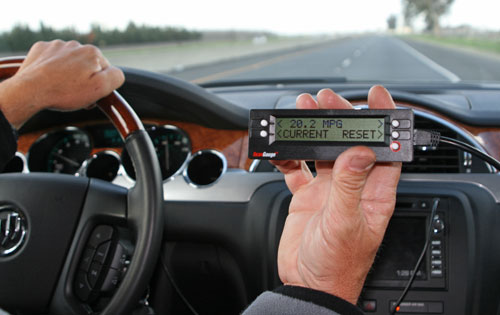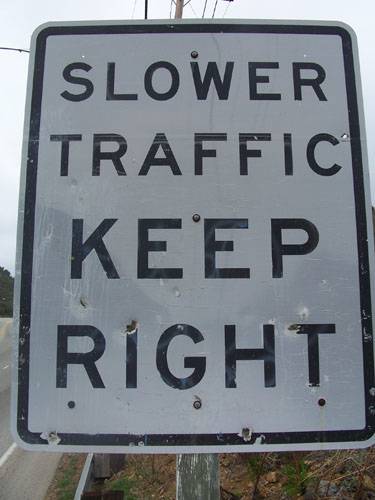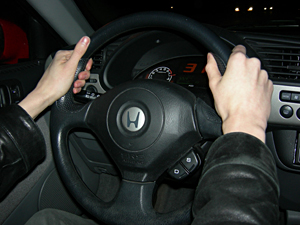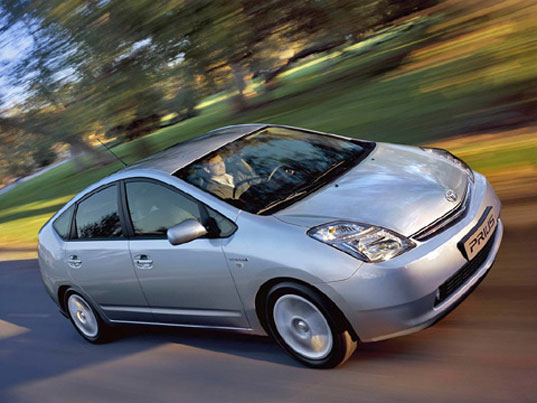|
|
|||||||||||||||||||||||||||||||
|
Hypermiling - Saving Gas while Driving
Saving Gas while DrivingBy Patrick Ross. Hypermiling was coined by Wayne Gerdes, a Homer Simpson-like nuclear power plant worker in Illinois who demonstrated how he could push the performance envelop of hybrid vehicles not to go faster, but to go farther on a gallon of gas. Lets stop pretending there isn't a problem with current gasoline prices, because there is definitely a problem. A young man came to my house yesterday to fix something and he had a worried look on his face. He lives 30 km away. The fuel tank in his little van was perilously close to empty and he simply didnít have enough money to fill it up again. It used to be many of us only stopped for fuel when the yellow light had been on for a month and the engine was starting to cough. These days I stop at a gas station just because the price is a nickle cheaper than usual. Saves me about $5 each time I stop for a better price and in theory works out to about $600 a year in savings. Except of course these calculations are meaningless because oil, as I write, is $140 a barrel and no one thinks itís going to stop there. With India and China exchanging their richshaws for shiny new Toyotas prices are doomed to keep going up. They say itíll be $150 a barrel by the end of summer. OPEC is predicting $170 within the next year. Global warming was never going to get people out of their SUVs because we could see it was all a bunch of left-wing eco-friendly economics. But when gasoline is $8 a gallon in the United States and $2 a litre in Canada Ė and anyone old enough to remember 1973 would not discount that as a possibility Ė youíd have to be a complete idiot to drive around like your hairís on fire in a car that does only eight miles to the gallon. Oh itís all very well now. You may be somebody rich or at least quite well off. You see expensive gasoline as a jolly good way of getting the poor and the weak off the roads. Sooner or later it will effect you too. Think about it. When you have to wrestle with an old lady over the last loaf of expensive bread in the grocery store, and your electricity bill looks as though itís been written in pesos, you are going to find yourself in the same boat as my repair man: with a nice big car on the driveway and no money or gasoline to make it go. Of course there are lots of things you can do to lessen the impact of skyrocketing gasoline.
WeightIf you remove that rolled-up old carpet and the dead body from the trunk of your car youíll be surprised at the impact itíll have on your fuel economy. You could go further and remove your spare wheel and jack too. Maybe you could finally go on a diet yourself. Remove any roof bars (if you can manage without) and you will save 3% right there. If you make a search of the car for any unnecessary weight you could probably shed quite a few pounds of junk that properly belongs in a trash can and not hiding under your car seat.
Electrical EquipmentIf you use a lot of electrical stuff while driving, the alternator will need to work harder, which means more fuel. The radio and stereo speakers use a lot more energy than you realize. Your heated rear window needs an alarming amount of electricity. If you know where you are why is your sat nav on? And air-conditioning? Turn that off and your fuel economy will improve by as much as 12%. Don't leave your car to warm up in winter (new technologies have made it unnecessary), and avoid idling.
Tires and MaintenanceMaking sure that your tires are inflated properly will save another 5%. Change your air filter annually.
Driving MethodologyIf you change the way you drive you can increase your fuel economy by a whopping 33%. Driving 5 to 10 miles slower than your regular speed saves approximately 10% alone. On a downhill stretch, ease up on the throttle pedal and work with gravity to build up speed. Similarly you can ease off the power and use momentum to get you up the next hill. A cruise control system will not do this. It is a sledgehammer when what you need is the scalpel sensitivity of your right foot. Look far ahead. If you think you will have to slow down, start the process early. If you use the brakes you are simply wasting the fuel you used to reach a speed that was unnecessary. Avoid quick acceleration and never exceed the speed limit Always drive in the right lane whenever possible to reduce wind resistance. Do NOT tailgate behind transport trucks unless you want to get crushed to death by one. Plan your route to avoid congestion, hills and left turns.
DO NOTThere are a variety of techniques that are outright dangerous, such as the pulse-and-glide method, as well as surfing/drafting behind a transport truck. The truck driver can't see you and when he stops or slows down you will crash a lot faster than you expect. Do not overfill your tires as they may cause a dangerous blowout. Crazy hypermiling stunts aren't only dangerous but can get you arrested for reckless driving. Slowing down is the wisest course of action and police are much more in favour of that technique.
BoredomHypermiling can be quite boring and sweaty depending on the temperature outside. Talking to any passengers is best, but if it really bothers you the radio is probably the best choice. Try to use your air conditioner sparingly. Doing all these things to save yourself some cash may seem rather depressing at times but think of all the things you could buy with the cash you saved. I should also point out that hypermiling is a rather safe and courteous way to drive. You'll suffer less road rage and get there in roughly the same amount of time anyway. Due to the stop and go nature of traffic lights speeding between stops doesn't really get you there any faster than if you had gone slowly. Driving in this fashion just isn't for some people who love driving aggressively and dangerously. Such people will no doubt be annoyed when they spot you coasting to a stop and may express their road rage by giving them the finger. These are the kind of people who will likely end up killing themselves or someone else "accidentally" some day with their aggressive and careless driving. Don't let them bother you, you're setting a good example and are part of a growing trend. Many hypermilers add an aftermarket real-time fuel consumption display to the dashboard of their vehicle so they can watch the consumption numbers rise and fall as they drive. The digital displays have turned fuel-efficient driving into a videogame, where high scores and boasts are posted daily on hypermiler websites. Hypermiling is hardly new. Practices such as coasting to a stop were popular during World War II when oil was scarce and the U.S. national speed limit was reduced to 55 m.p.h. (88 km/h) during the oil embargo of the 1970s. What is new is the sudden fascination with the phenomenon, thanks to information sharing through the Internet.
Quotes about Hypermiling"On my Toyota Celica, I installed a duct-tape upper and lower grille block, change gears at 1700 r.p.m., avoid traffic lights and turn the engine off when stopped. My current average is 54 m.p.g. (5.2 L/100 km)," - Blogger. "Draft my rig, and they'll be cleaning your blood off the bumper with a sponge," - Trucker. "If you're right behind a big truck, you can't see what's ahead so your reaction time is compromised when the truck driver slams on his brakes. There's no margin for error." - Police Sgt. Tim Burrows of Toronto Police Traffic Services. "Drafting is like NASCAR. Don't do that on the road or you'll be dead." - Wayne Gerdes, Hypermiling promoter. "I tried some of the more modest techniques suggested by the hypermilers with a 2000 Windstar, and got 35 m.p.g. on the highway Ė a 60 per cent increase in mileage." - Blogger. "Go hypermiling! A sport that one can respect because in the end, it's a healthy competition anyone can do," - Blogger. "In a time when our people are losing their lives in Iraq for oil, we should use every drop as efficiently as possible. I drive the speed limit now and use cruise control and let everyone pass me," - American. "It reminds me of when we had the fuel blockades in the U.K. in 2000. Suddenly everyone was driving like a grandmother," - Blogger. "A squirrel lived yesterday because I was coasting down for a corner, both slowly and aware that there was no SUV on my ass." - Blogger.
Expensive Gasoline, Hybrid Cars & ElectricsWith oil prices near $140 a barrel, motorists are starting to look seriously at both alternative fuels and electric vehicles as a way to be able to keep driving their cars. But experts say it will take five to 10 years for these alternatives to take root, given the capacity challenge for an auto industry that is adding 65 million new cars a year to a fleet of 1 billion. In the meantime, car and parts makers, oil companies and even electricity generators are left guessing which way motorists will turn and what technology will win. "We don't know at the moment whether it's battery-based electricity technology or sustainable biofuels that will be successful," said James Smith, chairman of Shell UK Ltd, speaking at a climate change seminar hosted by Reuters. "The strategic issues confronting us are very significant." A range of options will emerge as motorists pick between "plug-in" electric cars, longer-range gasoline-electric "hybrids," or simply downsized, more efficient gasoline and diesel models, and as governments, worried by global warming and energy security, give more or less support for biofuels. Hybrid vehicles, which have both a conventional internal combustion engine and electric motor and battery, are already popular. Toyota Motor Corp has sold 1.5 million Prius hybrids since 1997 and it wants hybrids to reach one tenth of its total sales by 2011. In a hybrid, the electric battery and motor aid stop-start city driving, while the gasoline engine allows longer trips, together cutting energy use and carbon emissions. Hybrids accounted for 3 percent of U.S. car sales in 2007. Makers absorb most of the extra $5,000 engine cost, leaving the street price only $1000 to $2000 higher. Hybrids could be "broadly present" in the auto industry in five years, said Vlatko Vlatkovic, head of electrification research at GE, which has much to gain from widespread electrification of road transport. Paul Nieuwenhuis, automotive researcher at Cardiff University in Wales, said that hybrids like the Prius are soon likely to be overtaken by plug-in hybrids, which will have the extra option to charge from the grid. General Motors Corp wants its plug-in hybrid, the Chevy Volt, to reach showrooms in 2010. European brands including Mercedes, Volkswagen and BMW and Japan's Honda plan rivals. Pure plug-in electric cars, meanwhile, have no combustion engine at all and have struggled to shake off a quirky image Ė with tiny sales of fabulous cars at prohibitive prices or else economy-sized "golf carts," both with limited range. Tesla Motors of San Carlos, California, advertises a Roadster with a top speed of 125 miles per hour (200 kmh) and a range of 220 miles (320 km). But Linda Nicholes, president of electric car pressure group "Plug in America," is still awaiting delivery two years after ordering hers at a price of $100,000. "We've been waiting eagerly ever since. I've been told September (2008)," said Nicholes, who is nonetheless still excited. "It's sleek, snazzy. All will be forgiven." For those who can't wait, Monaco's privately held Venturi is marketing a 297,000 euros ($460,900) electric car with a top speed of 160 kilometres per hour (100 mph), called 'Fetish'. "It's the pleasure to drive which will make it someone's favourite object," a spokeswoman said, explaining the name and adding it had sold five models on an expected 25-unit run. Meanwhile, specialist car producer Think, based in Oslo, plans a run of 8,000 full electric cars in 2009 at 20,000 euros ($30,860) each. And a Renault-Nissan alliance plans to start deploying full electric cars from 2010. Electric car developments hinge on batteries which are light but pack enough power to travel more than 100 miles (160 km). Aggressive conversion of the global fleet to electric alternatives may take 30 years, said Charles Gassenheimer, chairman of lithium-ion battery supplier Ener1, based in Fort Lauderdale, Florida. Alternatively, you can keep your car but switch the fuel, up to a point. Sugar-based biofuels are making serious headway against gasoline in Brazil, where nearly 90 percent of new cars have flex-fuel engines, which burn any combination of the two. In the United States, tax breaks help biofuels made from corn supply about 2 percent of the domestic fuel mix. But biofuels made from crops such as corn aren't the near-term replacement for gasoline, either. A finite supply of farm land has pitted them against food, inflating grain prices. A tank of standard, U.S. corn biofuel blend, called E10, contains enough calories to sustain an adult man for 11 days. That underlines the problem of using food to make car fuel while 850 million people in the world are hungry. Limited scope for global crop yields improvements will limit such "first generation" biofuels. Further off, sustainable biofuels which come from algae or woodchips and don't compete with food, may reach 10 percent of U.S. road fuel by 2022. While some experts say that cars fueled by hydrogen fuel cells, which rely on the conversion of hydrogen and oxygen into water and which don't have harmful emissions, are promising, the technology is still in its infancy. Honda Motor Co, began production on June 16 of a new fuel-cell car, the FCX Clarity, but has plans to sell only 200 in the United States and Japan in the next three years. The biggest hurdles for proliferation of hydrogen cell vehicles are a lack of fuelling stations and the high cost of development.
|
|
||||||||||||||||||||||||||||||
|
Website Design + SEO by designSEO.ca ~ Owned + Edited by Suzanne MacNevin | |||||||||||||||||||||||||||||||



